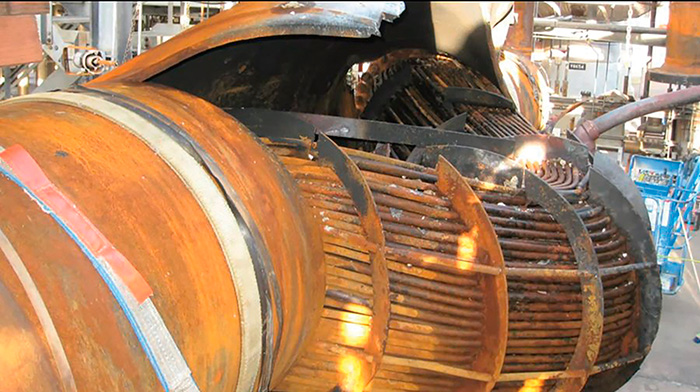Safety is a concern at any industrial site. An Occupational Safety and Health Administration compliance specialist has stated that safety should be more than a priority: “Priorities in an organization can and usually do change. Safety and health need to be a core value of the organization.”1 Safety can be a case of values versus priorities. When it comes to sealing devices, perceived dangers sometimes are overlooked. The case of an explosion at a refinery in Anacortes, Washington, shows how deadly accidents can occur when safety risks are distorted. A heat exchanger, known as E-6600E, catastrophically ruptured at the Tesoro refinery in Anacortes on April 2, 2010 (see Image 1). Highly flammable hydrogen and naphtha at more than 500 F were released from the ruptured heat exchanger and ignited, causing an explosion and an intense fire that burned for more than three hours. The rupture fatally injured seven Tesoro employees (one shift supervisor and six operators) working near the heat exchanger.
 Image 1. Ruptured heat exchanger (Courtesy of the U.S. Chemical Safety Board)
Image 1. Ruptured heat exchanger (Courtesy of the U.S. Chemical Safety Board)Avoid Gasket Reuse
Why should a gasket not be reused? First, when gaskets are installed they are compressed and take a permanent set. The gasket’s whole design is to conform to the flange face and seal. If the gasket were 100 percent elastic—such as with homogeneous rubber sheet and molded parts used at ambient temperature and not exposed to elevated temperature—reuse would not be such an issue. When a sheet gasket made of compressed fibers, inert fillers with rubber binders or polytetrafluoroethylene (PTFE), or metal with flexible graphite filler/laminate is compressed, it is irreversibly densified. When the compressive load is released, it does not return to its original shape. It will not seal under the same assembly conditions as it did when first installed. Second, heat changes the gasket material’s form and properties. Heat will cure and harden gasket materials that contain rubber. At elevated temperatures, the metal used in 100 percent metal and composite metal gaskets can be subject to the reduction of their yield point. Elevated temperature will alter stress versus strain characteristics, taking the material out of the elastic region—causing permanent deformation and a reduction or elimination of resilience.Understand Thermal Growth
Besides reuse of the gasket, another problem that occurred in this accident is a loss of seating stress caused by thermal growth. When process equipment goes from ambient to elevated temperature, a flange connection’s components are subject to thermal growth and movement. Axial and radial growth of heat exchanger flanges is substantial. Thermal growth rate differences of head flanges, tube-sheets, bolts and gaskets create an upset of the gasket-flange interface and a loss of seating stress on the gasket that can cause flanges to leak. As the equipment heats, the exchanger flanges’ faces grow axially and radially. Axial growth causes compressive stresses on the gasket beyond what was provided by the bolt pre-load. Because the flanges and gasket are made of different material, the rates of thermal expansion are different. Radial growth causes the flange surfaces to wipe across the gasket, upsetting the gasket-flange interface and potentially causing leak paths. Some gaskets, such as corrugated metal with flexible graphite laminates, handle this service better than others. A test developed by the now-defunct Tightness Testing and Research Laboratory of the Polytechnique Montréal included an evaluation to address this called the Radial Shear Test (RAST). Another technology (flange springs) could have been used to give more travel during this time that could have kept a larger seating stress on the gasket. The 2010 explosion at Anacortes was not directly caused by poor gasket application. The NHT heat exchanger vessel ruptured and caused the fire because of the vessel material’s high temperature hydrogen attack, which is metal deterioration from high temperature hydrogen contact. Because of safety complacency that accepted heat exchanger leaks during startup, additional personnel were required to manage those leaks, which led to the tragic loss of life. Technology and know-how are available to assure safe sealing that can make sure everyone safely ends the work day. References- “OSHA Update,” presentation given to the Monroe Professional Engineers Society on Sept. 27, 2016, by Gordon DeLeys, OSHA Compliance Assistance Specialist
- Report can be downloaded at the U.S. Chemical Safety Board website: http://www.csb.gov/tesoro-refinery-fatal-explosion-and-fire/

